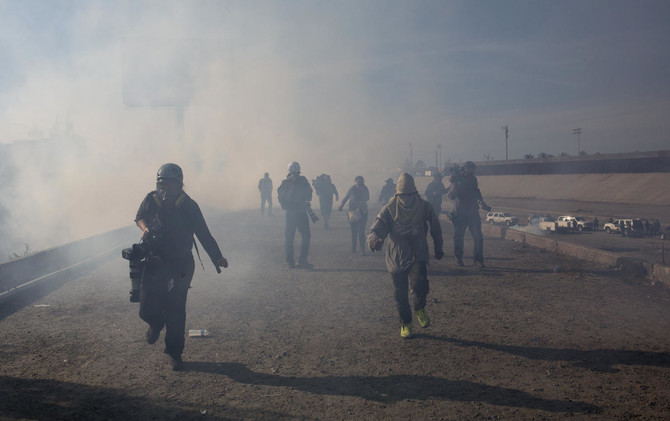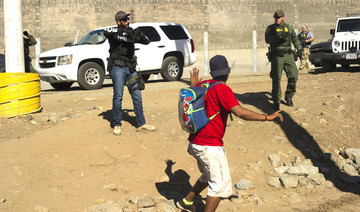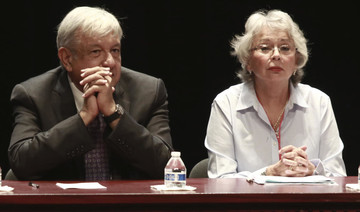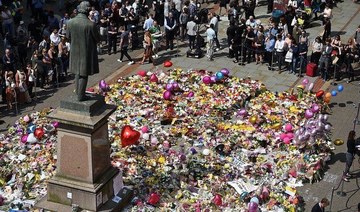SAN DIEGO: President Donald Trump is strongly defending the US use of tear gas at the Mexican border to repel a crowd of migrants that included angry rock-throwers but also barefoot, crying children.
Critics denounced the border agents’ action as overkill, but Trump kept to a hard line.
“They were being rushed by some very tough people and they used tear gas,” Trump said Monday of the previous day’s encounter. “Here’s the bottom line: Nobody is coming into our country unless they come in legally.”
At a roundtable in Mississippi later Monday, Trump seemed to acknowledge that children were affected, asking, “Why is a parent running up into an area where they know the tear gas is forming and it’s going to be formed and they were running up with a child?“
He said it was “a very minor form of the tear gas itself” that he assured was “very safe.”
Without offering evidence, he also claimed that some of the women are not really parents but are instead “grabbers” who steal children so they have a better chance of being granted asylum in the US
The showdown at the San Diego-Tijuana border crossing has thrown into sharp relief two competing narratives about the caravan of migrants hoping to apply for asylum but stuck on the Mexican sider. Trump portrays them as a threat to US national security, intent on exploiting America’s asylum law, but others insist he is exaggerating to stoke fears and achieve his political goals.
The sheer size of the caravan makes it unusual.
“I think it’s so unprecedented that everyone is hanging their own fears and political agendas on the caravan,” said Andrew Selee, president of the Migration Policy Institute, a nonpartisan think tank that studies immigration. “You can call it scary, you can call it hopeful, you can call it a sign of human misery. You can hang whatever angle you want to on it.”
Trump rails against migrant caravans as dangerous groups of mostly single men. That view featured heavily in his speeches during the midterm election campaign when several were hundreds of miles away, traveling on foot. Officials have said some 500 members are criminals, but haven’t backed that up with details on why they think so. On Monday, Trump tweeted the caravan at the border included “stone cold criminals.”
Mario Figueroa — Tijuana’s social services department director who is overseeing operations at the sports complex where most of the migrants in the caravan are staying — said as of Friday that of the 4,938 staying there, 933 were women, 889 were children and 3,105 were men, which includes fathers traveling with families along with single men.
The US military said Monday that about 300 troops who had been deployed in south Texas and Arizona as part of a border security mission have been moved to California for similar work. The military’s role is limited largely to erecting barriers along the border and providing transportation and logistical support to Customs and Border Protection.
Democratic lawmakers and immigrant rights groups blasted the border agents’ Sunday tactics.
“These children are barefoot. In diapers. Choking on tear gas,” California Governor-elect Gavin Newsom tweeted. “Women and children who left their lives behind — seeking peace and asylum — were met with violence and fear. That’s not my America.”
US Customs and Border Protection Commissioner Kevin McAleenan said the administration’s concerns about the caravan “were borne out and on fully display” Sunday.
McAleenan said hundreds — perhaps more than 1,000 — people attempted to rush vehicle lanes at the San Ysidro crossing. Mexican authorities estimated the crowd at 500. The chaos followed what began as a peaceful march to appeal for the US to speed processing of asylum claims.
After being stopped by Mexican authorities, the migrants split into groups. On the west side of the crossing, some tried to get through razor-wire fencing in a concrete levee that separates the two countries. On the east side, some pulled back a panel of fencing made of Army surplus steel landing mats to create an opening of about 4 feet, through which a group of more than 30 people crossed, according to a US official who was not authorized to discuss the matter publicly and spoke on condition of anonymity. Others made it over a steel fence farther east.
McAleenan said four agents were struck with rocks but were not injured because they were wearing protective gear.
Border Protection agents launched pepper spray balls in addition to tear gas in what officials said were on-the-spot decisions made by agents. US troops deployed to the border on Trump’s orders were not involved in the operation.
“The agents on scene, in their professional judgment, made the decision to address those assaults using less lethal devices,” McAleenan told reporters.
The scene was reminiscent of the 1980s and early 1990s when large groups of migrants rushed vehicle lanes at San Ysidro and overwhelmed Border Patrol agents in nearby streets and fields.
US authorities made 69 arrests on Sunday. Mexican authorities said 39 people were arrested in Mexico.
The incident left many migrants feeling they had lost whatever possibility they might have had for making asylum cases.
Isauro Mejia, 46, of Cortes, Honduras, looked for a cup of coffee Monday morning after spending Sunday caught up in the clash.
“The way things went yesterday ... I think there is no chance,” he said.
Mexico’s Interior Ministry said in a statement it would immediately deport those people arrested on its side and would reinforce security.
Border Patrol agents have discretion on how to deploy less-than-lethal force. It must be both “objectively reasonable and necessary in order to carry out law enforcement duties” — and used when other techniques are not sufficient to control disorderly or violent subjects.
Last week Trump gave Defense Secretary Jim Mattis explicit authority to use military troops to protect Customs and Border Protection agents on the border, with lethal force if necessary. Mattis also was empowered to temporarily detain illegal migrants in the event of violence against the border patrol. Mattis told reporters this did not change the military’s mission in any way, and that he would use the new authorities only in response to a request by Homeland Security Secretary Kirstjen Nielsen. He said there had been no such request yet.
With the caravan as a backdrop, Trump has used national security powers to circumvent longstanding immigration law to deny asylum to anyone caught crossing the border illegally. However, a court has put those regulations on hold after civil liberties groups sued. On Thanksgiving Day, the president warned of “bedlam, chaos, injury and death” if the courts block his efforts to harden immigration rules.
But it’s also possible that Sunday’s clash was borne of increasing desperation caused by the hardening of the policies, said Rachel Schmidtke, program associate for migration at the Woodrow Wilson International Center for Scholars Mexico Institute.
“This situation is now escalating to the point of a self-fulfilling prophesy,” she said. “The more you squeeze the more it artificially creates something that didn’t exist, but now is starting to become a crisis.”
Trump strongly defends use of tear gas on caravan migrants
Trump strongly defends use of tear gas on caravan migrants

- Critics denounced the border agents’ action as overkill, but Trump kept to a hard line
- “They were being rushed by some very tough people and they used tear gas”
Civilians evacuated from northeast Ukraine as Russia steps up assault

- Heavy fighting raged on Sunday as Russia attacks 27 settlements
KYIV: Thousands more civilians have fled Russia’s renewed ground offensive in Ukraine’s northeast that has targeted towns and villages with a barrage of artillery and mortar fire, officials said Sunday.
The intense battles have forced at least one Ukrainian unit to withdraw in the Kharkiv region, capitulating more land to Russian forces across less defended settlements in the so-called contested “gray zone” along the Russian border.
Meanwhile, a 10-story apartment block collapsed in the Russian city of Belgorod, near the border, with several deaths and injuries reported. Russian authorities said the building collapsed following Ukrainian shelling. Ukraine has not commented on the incident.
HIGHLIGHT
The Russian Defense Ministry said Saturday that Moscow’s forces had captured five villages on the border of Ukraine’s Kharkiv region and Russia. Ukraine’s leadership has not confirmed Moscow’s gains.
At least 4,000 civilians have fled the Kharkiv region since Friday, when Moscow’s forces launched the operation, Gov. Oleh Syniehubov said in a social media statement. Heavy fighting raged Sunday along the northeast front line, where Russian forces attacked 27 settlements in the past 24 hours, he said.
Analysts say the Russian push is designed to exploit ammunition shortages before promised Western supplies can reach the front line. Ukrainian soldiers said the Kremlin is using the usual Russian tactic by launching a disproportionate amount of fire and infantry assaults to exhaust their troops and firepower.
It comes after Russia stepped up attacks in March targeting energy infrastructure and settlements, which analysts predicted were a concerted effort by Moscow to shape conditions for an offensive.
Ukrainian President Volodymyr Zelenskyy said that disrupting Russia’s offensive in the area was a priority, and that Kyiv’s troops were continuing counteroffensive operations in seven villages around the Kharkiv region.
“Disrupting the Russian offensive intentions is our number one task now. Whether we succeed in that task depends on every soldier, every sergeant, every officer,” Zelenskyy said.
The Russian Defense Ministry said Saturday that Moscow’s forces had captured five villages on the border of Ukraine’s Kharkiv region and Russia. These areas were likely poorly fortified due to the dynamic fighting and constant heavy shelling, easing a Russian advance.
Ukraine’s leadership has not confirmed Moscow’s gains.
Black, Asian and minority ethnic people make up nearly 70% of UK’s anti-terror detentions, data shows

- Fewer than 1 in 5 who were stopped were recorded as white
LONDON: Nearly 70 percent of people stopped at UK ports under anti-terrorism laws since 2021 were from Black, Asian and minority ethnic backgrounds, new figures released on Sunday show.
The Guardian newspaper requested police data under freedom of information laws, which also revealed fewer than one in five who were stopped were recorded as white.
Campaigners have criticized the statistics, saying they prove the UK’s anti-terrorism laws are disproportionately affecting Black and minority ethnic groups and not being used effectively enough to arrest the rise of far-right, white extremism, The Guardian reported.
Of the 8,095 people stopped at UK ports since 2021 under Schedule 7 of the Terrorism Act 2000, 5,619 (69.4 percent) were recorded as being from Black, Asian and minority ethnic backgrounds, compared with 1,585 (19.6 percent) recorded as white British, white Irish or white other stopped under the same law.
The head of public advocacy at the anti-Islamophobia group Cage International has also pressed British police to publish data on the religious background of those stopped under the Terrorism Act.
Anas Mustapha said: “This new data reaffirms what we already know about its racist and Islamophobic impact. However, despite evidence demonstrating that the majority of those stopped are Muslim and that forces record data on religion, the government has resisted calls to produce a religious breakdown of those harassed at the borders.
“Schedule 7 is one of the most intrusive and discriminatory of all police powers. We’ve supported hundreds of British holidaymakers impacted by the policy and it’s clear that the power is abused and must be repealed.”
A spokesman from the UK’s counter-terrorism police said the law was a “vital tool” in collecting evidence to support convictions of terrorists, as well as helping with intelligence-gathering in the prevention of attacks on British streets.
“The use of Schedule 7 powers regularly features in some of our most complex and high-risk investigations and prosecutions,” the spokesman said.
“We face an enduring terrorist threat from overseas, and whilst we are seeing a much greater prevalence of online activity, travel remains an element of terrorist methodology that provides us with potentially crucial opportunities to act.
“Where the powers are used, there are a range of robust safeguards and measures in place to ensure appropriate usage.”
OIC calls for immediate aid amid Afghan flood crisis

- Flash floods from seasonal rains in Baghlan province in northern Afghanistan
RIYADH: The Organization of Islamic Cooperation has issued an urgent appeal to its member states as well as relief organizations to provide aid to the Afghan people amid catastrophic flooding which has hit the country, Saudi Press Agency reported on Sunday.
Flash floods from seasonal rains in Baghlan province in northern Afghanistan killed at least 315 people since striking on Friday, a UN report said.
Rains also caused heavy damage in northeastern Badakhshan province and central Ghor province, officials said.
Since mid-April, floods have left about 100 people dead in 10 of Afghanistan’s provinces, with no region entirely spared, according to authorities.
Farmland has been swamped in a country where 80 percent of the more than 40 million people depend on agriculture to survive.
UK investigating Hamas’ claim that British hostage killed in Gaza

- Foreign secretary confirms viewing video
LONDON: The UK’s Foreign Office said on Sunday it was investigating a claim by Hamas that a British-Israeli hostage in Gaza had died from injuries sustained in an Israeli airstrike over a month ago.
Nadav Popplewell, 51, was captured along with his mother Channah Peri on Oct. 7 during a border incursion when the Palestinian group launched a surprise attack on Israel.
The Foreign Office said it was actively seeking more information on the matter.
Popplewell’s family has requested media outlets refrain from airing footage released by Hamas, showing him in captivity with visible injuries, the BBC reported.
The UK’s Foreign Secretary David Cameron, speaking to the BBC’s Laura Kuenssberg, confirmed viewing the video but provided no further updates on the investigation.
Cameron said: “We don’t want to say anything until we have better information.”
He described Hamas as “callous” for releasing the video and playing “with the family’s emotions in that way.”
The Foreign Office added that the department’s thoughts “are with his family at this extremely distressing time.”
The Israeli military has not issued a statement on the matter.
Israel’s military campaign in Gaza to destroy Hamas has killed over 34,900 people, the majority of whom are women and children, according to the Gaza Health Ministry.
Israel has reported that 128 hostages are unaccounted for.
UK mountaineer logs most Everest climbs by a foreigner, Nepali makes 29th ascent

- Both climbers used Southeast Ridge route to summit
- They were on separate expeditions guiding their clients
KATMANDU: A British climber and a Nepali guide have broken their own records for most climbs of Mount Everest, the world’s highest mountain, hiking officials said on Sunday.
Rakesh Gurung, director of Nepal’s Department of Tourism, said Britain’s Kenton Cool, 50, and Nepali guide Kami Rita Sherpa, 54, climbed the 8,849-meter (29,032 foot) peak for the 18th and 29th time, respectively.
They were on separate expeditions guiding their clients.
“He just keeps going and going... amazing guy!” Garrett Madison of the US-based expedition organizing company Madison Mountaineering said of the Nepali climber. Madison had teamed up with Kami Rita to climb the summits of Everest, Lhotse, and K2 in 2014.
K2, located in Pakistan, is the world’s second-highest mountain and Lhotse in Nepal is the fourth-tallest.
Lukas Furtenbach of the Austrian expedition operator Furtenbach Adventures called Cool’s feat remarkable.
“He is a fundamental part of the Everest guiding industry. Kenton Cool is an institution,” Furtenbach, who is leading an expedition from the Chinese side of Everest, told Reuters.
Both climbers used the Southeast Ridge route to the summit.
Pioneered by the first summiteers, New Zealander Sir Edmund Hillary and Sherpa Tenzing Norgay in 1953, the route remains the most popular path to the Everest summit.
Kami Rita first climbed Everest in 1994 and has done so almost every year since, except for three years when authorities closed the mountain for various reasons.
He climbed the mountain twice last year.
Mountain climbing is a major tourism activity and a source of income as well as employment for Nepal, home to eight of the world’s 14 tallest peaks, including Everest.
Nepal has issued 414 permits, each costing $11,000 to climbers for the climbing season that ends this month.


















